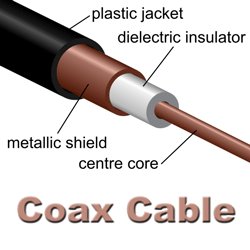Many small businesses don’t fit into the “residential” user category but don’t require or can’t afford expensive traditional business telecom services like T1 lines or Ethernet over Copper. One solution is HFC, or Hybrid Fiber Coax, broadband services.

You might know this as “Cable broadband for business.” Many home-based businesses successfully use it to manage websites, access online information, and send and receive emails. However, ordering residential service for a business location usually results in rejection. That’s because residential broadband pricing suits single homes and apartments with few users and limited daytime activity. Consequently, some business owners wrongly assume they can’t get Cable service. However, they can.
So, what’s available, and why the unusual name? HFC, or Hybrid Fiber Coax, refers to the technology used to deliver high-speed internet, telephone service, and Cable television. Cable TV and Cable broadband get their names from the coaxial cable connecting to the network. When first deployed, Cable systems were constructed using various coaxial cable sizes. In recent years, the long connection from the Cable office or “head end,” where signals are received and transmitted for miles, has been replaced with fiber optic cable. The final few hundred feet typically remain copper coaxial cable, also called coax. This creates a system combining fiber optic and coax cable, known as Hybrid Fiber Coax or HFC.
Why use a hybrid setup instead of just fiber optics? It’s primarily a cost issue. While fiber has much greater capacity, a lot of coax already exists. The on-site connection, either a Cable modem or set-top box, is far cheaper than fiber termination equipment. Don’t discount coax just yet, though. With digital signals, there’s ample bandwidth for triple-play services to small and medium businesses and consumers.
With an established infrastructure and a large user base to cover expenses, you might anticipate HFC services to be more affordable than other telecom options for SMBs. You’d be correct. However, understanding the performance tradeoffs is crucial for a wise purchasing decision.
One excellent use for HFC is broadband internet access when employees primarily browse the web and use email. This includes research, online purchases, simple banking, customer messaging, providing a WiFi hotspot, and so on. If your usage mirrors home computer use, HFC should suffice. You choose a bandwidth tier that provides adequate speed while saving money compared to alternatives. Typical bandwidth for smaller businesses goes up to 15 Mbps download and 2 Mbps upload, although some Cable companies offer speeds as high as 50 or even 100 Mbps.
You’ll likely find a high-speed internet solution that meets your needs with significantly more bandwidth than a T1 line at a much lower cost. However, be aware that T1 lines offer dedicated bandwidth, consistently providing a stable 1.5 Mbps. Cable bandwidth is shared among all users on the Cable and can fluctuate considerably. This helps keep costs down. If you run high-traffic e-commerce servers or use business processes requiring consistent bandwidth, the speed variations might not justify the savings. Otherwise, you might be perfectly satisfied with HFC broadband’s performance and reliability.
Cable companies have also ventured into business telephone services, essentially VoIP. One significant difference between this service and running a third-party VoIP service over your broadband connection is that the Cable version never travels over the internet. Voice packets travel over the cable network and are then connected to the public telephone network by the Cable company or a telephone service provider. This gives the HFC operator more control over factors like latency, packet loss, and network congestion, ensuring decent voice quality.
Lastly, HFC offers Cable TV channels, as that’s the network’s original purpose. Businesses with waiting rooms, like auto service centers and doctor’s offices, can benefit from business Cable TV service.
Are you frustrated with your current network service options? Why not compare prices, availability, and service features of HFC, T1, and Ethernet to make an informed decision? You might be surprised by the available options.
Note: Diagram of coaxial cable construction courtesy of Wikimedia Commons.

